The Apple iPhone 6s and iPhone 6s Plus Review
by Ryan Smith & Joshua Ho on November 2, 2015 8:00 AM EST- Posted in
- Smartphones
- Apple
- Mobile
- SoCs
- iPhone 6s
- iPhone 6s Plus
Battery Life
With any smartphone, battery life is always one of the most important considerations. It probably goes without saying that more battery life is always better. In the case of the iPhone 6s, battery life is especially important to examine because this year Apple has actually made the battery of their phone smaller than before. Normally, it’s almost a given that battery size will be at least constant or increase but in order to accommodate additional components like the Taptic engine the battery has been made smaller. In light of this reversal one might assume that battery life has decreased as a result, but given the move to a FinFET process and other major component improvements it’s hard to say how battery life has increased or decreased. In order to test this properly, we ran the iPhone 6s’ through our suite of battery life tests to try and get an idea for overall battery life. As always, we run all battery life tests with the display set to an average of 200 nits and all possible background tasks disabled.
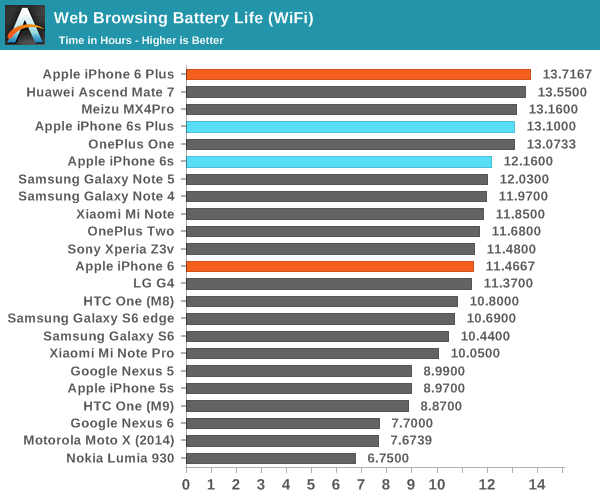
Our first test is WiFi web browsing, and here we see a pretty curious trend. The iPhone 6s Plus appears to regress relative to the iPhone 6 Plus, yet the iPhone 6s solidly beats the iPhone 6. I was pretty confused by this, but it’s likely that we’re seeing these results because the iPhone 6s is going to have larger relative power consumption of the SoC when compared to the display. As the display becomes bigger, the effects of SoC efficiency are just harder to notice, which also explains why it looks like the iPad Air 2 has effectively the same battery life whether you’re running just a blank display or our web browsing test. Both of our review units use a TSMC A9, so I don’t think we can attribute a foundry difference to the odd results that we’re seeing here.
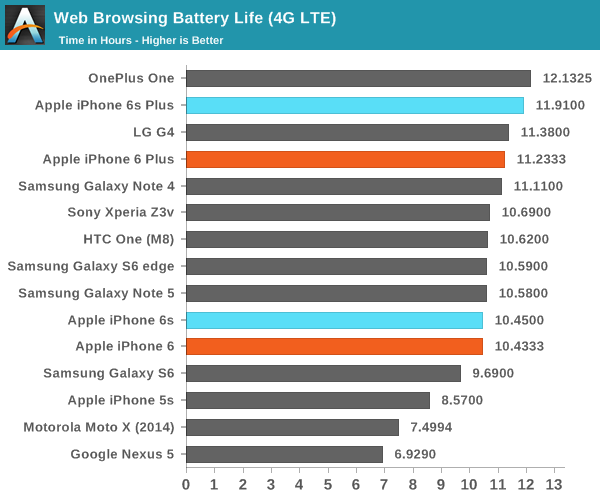
In LTE web browsing, we see a smaller improvement than what we observed in the WiFi test. This might seem strange, but given that the move from a 28nm process to a 20nm process on the modem from iPhone 6 to 6s didn’t come with FinFET it makes sense that the modem will remain a significant power drain. It’s likely that the next big jump in battery life here will come with FinFET process technology on the modem, along with other general modem design improvements.
In order to also look at battery life in more extreme scenarios, we use Basemark OS II and GFXBench to really place a strong stress on the CPU and GPU to see what power draw is like under sustained load. This also allows us to see the extent to which various components of the phone throttle down in response to relatively high sustained loads. However, it’s important to note that the Basemark OS II performance score here isn’t necessarily as accurate as scores from Android devices as the battery score can be calculated with 98 data points instead of 80 as battery score is partially derived from the rate at which the battery percentage decreases. It's also worth noting that in GFXBench there are two data points removed as the low power popup causes an incorrect frame rate to be recorded.
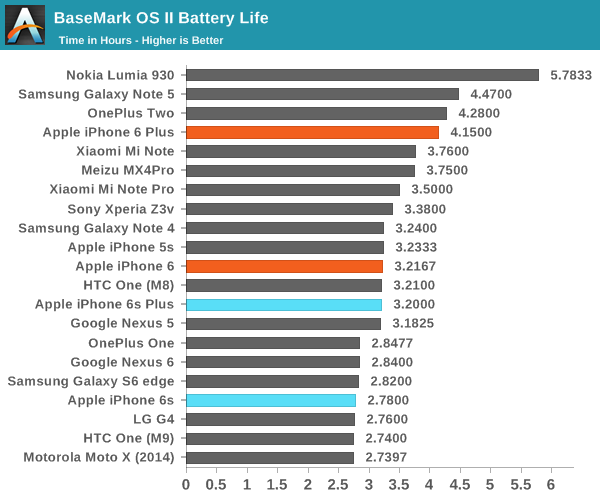
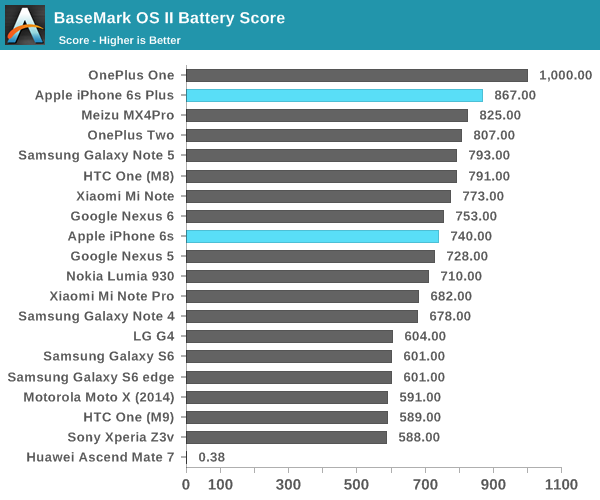
In Basemark OS II, we start off with a pretty shocking result as the iPhone 6s lasts less than three hours in this test, but looking at the battery score it’s pretty clear that the reason why the iPhone 6s doesn't last very long is because it’s running with relatively little throttling throughout the test, so the battery score is high as a result. The same is true of the iPhone 6s Plus, but the larger battery helps it to last a bit longer.
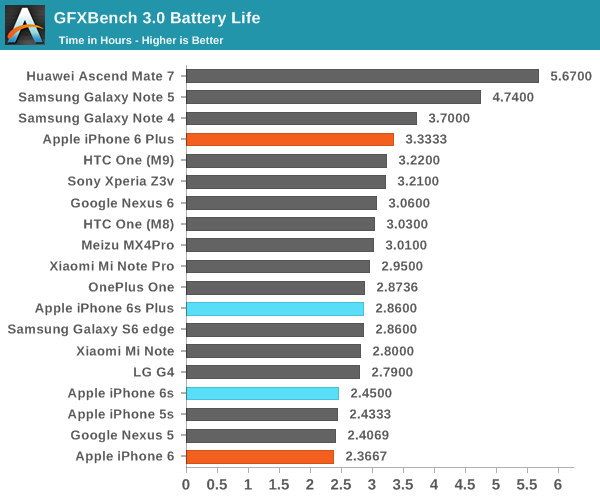
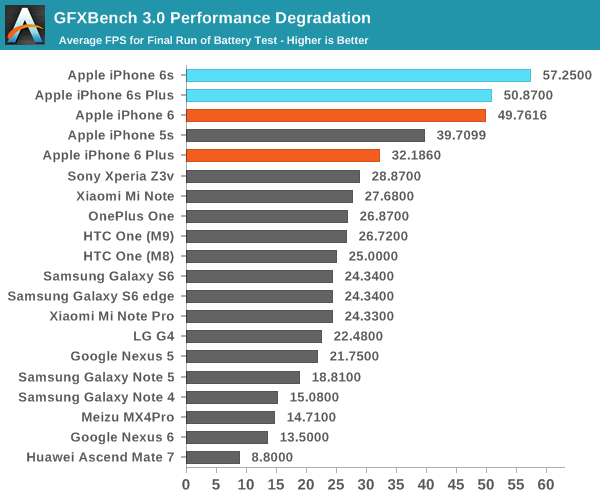
Looking at GFXBench, which is an infinite loop of the T-Rex on-screen benchmark to approximate intensive video gaming we see that the iPhone 6s doesn’t last very long either, but the performance throughout the test is incredible. Due to 1334x750 display resolution and strong GPU, the iPhone 6s manages to last the entire test without any notable throttling, and effectively pegged at the refresh rate of the display. The iPhone 6s Plus manages a similar level of performance but over time you can start to see some throttling, likely a function of the longer runtime and higher display resolution. It’s interesting to see how in the space of two years just how much progress has been made here in terms of improving GPU performance and efficiency, as when we first ran this test it was probably one of the most stressful tests out there for any smartphone or tablet.
Charge Time
Of course, while battery life is usually the main determinant of overall mobility it’s often important to consider charge time. A phone that charges slowly can be much less mobile than another phone, even if it has better battery life. In the case of the iPhone 6s’, it seems that Apple continues to ship the standard 5W charger that they have for many generations in the smartphone industry. In order to see how this charger and phone combination performs, we use our usual methods of timing the phone from fully discharged to fully charged.
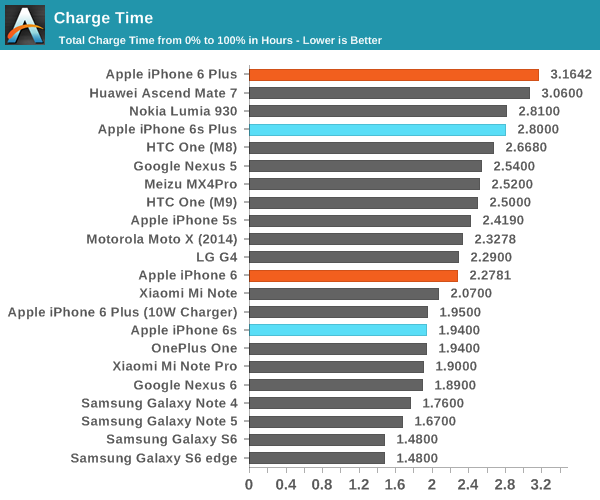
Here, the iPhone 6s and 6s Plus both show a decent improvement over the iPhone 6 and 6 Plus, but not enough to make an significant difference. The iPhone 6s charges at a pretty reasonable rate, but the iPhone 6s Plus really does need a more powerful charger than it does now. You can use an iPad charger to bring things back up to speed but getting this means that you either have to have an iPad already or you have to go out and buy an iPad charger, which is on the annoying side when Android OEMs generally include fast chargers in the box.




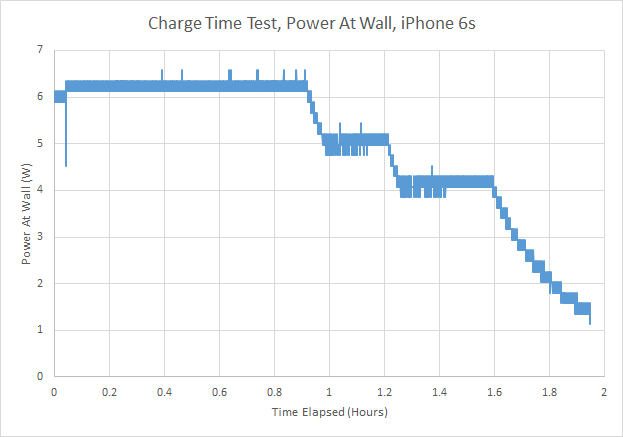
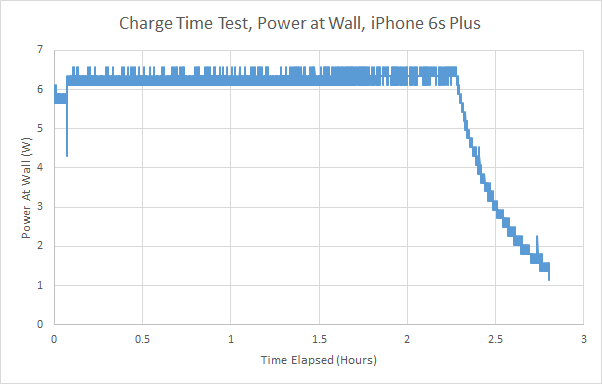








531 Comments
View All Comments
vFunct - Monday, November 2, 2015 - link
It's probably because they're the best.dysonlu - Tuesday, November 3, 2015 - link
Just like Lance Armstrong was too.vFunct - Tuesday, November 3, 2015 - link
I'm sure a lot of things are best in their category/field.The iPhone just happens to be one of them.
r3loaded - Monday, November 2, 2015 - link
If you now read the rest of the review, you'll find the evidence that supports their claim of being "the best".djsvetljo - Monday, November 2, 2015 - link
After reading the summary, I can't read the rest.ToastyFlake - Monday, November 2, 2015 - link
A leading symptom of fanboyitus.djsvetljo - Monday, November 2, 2015 - link
I am a complete opposite of fan boy. I use daily 2 phones, a BlackBerry10 and Android, equipped my business with ThinkPads and HPs, drive American and Japanese car. Never been a fan boy of anything but strive to get the best FOR MY NEEDS product available at the current time. And everybody has different needs. However, Anandtech (the Apple reviewers at least) doesn't know that. That's is what really bothers me right there. They are trying to tell me - if you want the best phone - get the 6s. Well guess what - you are wrong cause for my needs, it wouldn't last one business week for me.I have been reading their Apple articles for years - they do not compare equally (why they don't try to compare functions that are not present on Apple platforms - [standard] NFC, File Manager, File Sharing, Expansion ports, IR and so on). They have been doing the same thing for years. Same goes for MACs.
Chaser - Monday, November 2, 2015 - link
Maybe Anandtech should write special review just for you that revolves around "YOUR NEEDS". You admit you didn't read the review except the last paragraph but then you have all the time in the world to babble with your baseless tripe. Nice business I'm sure.djsvetljo - Monday, November 2, 2015 - link
Nobody gets it. All they have to do is add "one of" infront of every "the best" and point out the negatives of this phone like a man, not hide them like a mice who's "mother" works for the worship.solipsism - Monday, November 2, 2015 - link
1) They do point out negatives, but as you repeatedly stated, you refuse to read the article (or even use an Apple product).2) Putting "one of" doesn't alter anything in your "FOR MY NEEDS" argument as you made it clear no Apple product will ever last a week for you, so it would still be wrong, based on that. How about this, instead of trying to get the author to write specifically for you, why not try to look at it from the author's PoV or the mass-market PoV?